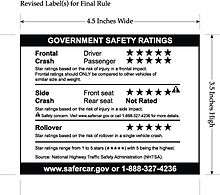New Car Assessment Program
A New Car Assessment Program (or Programme) is a government car safety program tasked with evaluating new automobile designs for performance against various safety threats.

History
The first NCAP was created in 1979, by the United States National Highway Traffic Safety Administration. This program was established in response to Title II of the Motor Vehicle Information and Cost Savings Act of 1972, to encourage manufacturers to build safer vehicles and consumers to buy them. Over time, the agency improved the program by adding rating programs, facilitating access to test results, and revising the format of the information to make it easier for consumers to understand.[1] NHTSA asserts the program has influenced manufacturers to build vehicles that consistently achieve high ratings.[1]
The first standardized, 35 mph front crash test was May 21, 1979, and the first results were released October 15 that year. The agency established a frontal impact test protocol based on Federal Motor Vehicle Safety Standard 208 (“Occupant Crash Protection”), except that the frontal 4 NCAP test is conducted at 56 km/h (35 mph), rather than 48 km/h (30 mph) as required by FMVSS No. 208.
The European program, Euro NCAP, was founded in 1997 by the Transport Research Laboratory for the UK Department for Transport and backed by several European governments, as well as by the European Union.[2] Based in Brussels, Belgium, the European program was modeled on the American program.[1] Other areas with similar programmes include Australia and New Zealand with ANCAP,[3] Latin America with Latin NCAP and China with C-NCAP.[4] The Bharat New Vehicle Safety Assessment Program is being planned for India.
In the 2000s, the American agency sought to improve the dissemination of NCAP ratings and as a result of the Safe, Accountable, Flexible, Efficient Transportation Equity Act: A Legacy for Users (SAFETEA–LU). It did so by issuing a Final Rule requiring manufacturers to place NCAP star ratings on the Monroney sticker (automobile price sticker). The rule has a September 1, 2007 compliance date.[5]
Organizations
Different NCAPs are:
| Name | Abbreviation | Founded | Location |
|---|---|---|---|
| United States New Car Assessment Program | US NCAP (U.S. NCAP) | 1978 | Washington, DC, USA |
| Insurance Institute for Highway Safety | IIHS | 1959, Ratings from 1995 | Arlington, VA, USA |
| Australasian New Car Assessment Program | ANCAP | 1993 | Canberra, Australia |
| Japan New Car Assessment Programme | JNCAP | 1995 | Tokyo, Japan |
| European New Car Assessment Programme | Euro NCAP | 1996 | Brussels, Belgium |
| Korean New Car Assessment Programme | KNCAP | 1999 | Seoul, South Korea |
| China – New Car Assessment Programme | C-NCAP | 2006 | Tianjin, China |
| Latin New Car Assessment Programme | Latin NCAP | 2010 | Montevideo, Uruguay |
| New Car Assessment Program for Southeast Asia | ASEAN NCAP | 2011 | Kajang, Selangor, Malaysia |
| Global New Car Assessment Programme | Global NCAP | 2011 | London, Great Britain |
| Bharat New Vehicle Safety Assessment Program | BNVSAP | 2017 | tbd |
| Green NCAP (operated by Euro NCAP for emissions) | Green NCAP | 2019 | Brussels, Belgium |
References
- "The New Car Assessment Program Suggested Approaches for Future Program Enhancements" (PDF). National Highway Traffic Safety Administration. January 2007. Retrieved 2008-11-24.
- Pernille Larsen (2011-05-25). "FIA Region I . Euro NCAP's standard set for upcoming electric and range-extender cars". Fiabrussels.com. Retrieved 2011-11-02.
- "ANCAP and EuroNCAP now aligned…". Practical Motoring. 2018-01-01. Retrieved 2020-07-11.
- "中国新车评价规程(C-NCAP)官方网站" [China's new car evaluation procedures (C-NCAP) official website] (in Chinese). China: C-NCAP. Archived from the original on 2017-02-15. Retrieved 2017-05-06.
- U.S. NCAP enhancements for 2007 Archived October 29, 2008, at the Wayback Machine